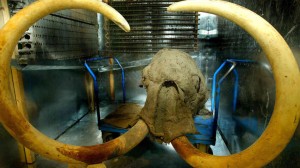Normally when an animal becomes extinct, it’s a permanent sentence. Never was there any thought about bringing an extinct animal back to life.
UNTIL NOW.
Within the past 10 years, science has opened doors to possibilities of reviving certain species of animals that perished long ago. Animals such as the woolly mammoth, dodo bird and saber-toothed tiger could be revived. Imagine it: taking your kids to a wildlife preserve and saying, “This animal lived during the Ice Age and now it’s back again.”

I can’t help but think of “Jurassic Park.” In theory, bringing back extinct species seems cool, but it soon becomes an ethics issue: “Who are we to play God?”
“If we’re talking about a species we drove extinct, then I think we have an obligation to try and do this,” said Michael Archer, a paleontologist from the University of New South Wales who was quoted in National Geographic. “I think we played God when we exterminated these animals.”
There is one species that has the potential to be successfully cloned and survive. The woolly mammoth, a distant relative to modern-day elephants, was said to have stood between nine and 11 feet tall with thick coats to protect them from the chilling weather. They became extinct between 7,000-10,000 B.C., but because they met their demise during the tail end of the Ice Age, many carcasses remained well preserved in the permafrost of Siberia.
The challenge lies with harvesting a viable egg from a modern day elephant (the Asian elephant was said to be the species of choice) and injecting it with a preserved nucleus taken from the mammoth remains. No one has successfully obtained an elephant egg.
While advances in medical technology have come very far, cloning still remains a mystery to us. The ibex experiment of 2009 ended with a newborn 4.5- lb clone of the Pyrenean ibex dying only 10 minutes after birth due to a lung deformity. Her maternal clone, “Celia,” the last of her kind, died in 2000 after spending nine months in the Monte Perdido National Park with a radio-tracking device strapped around her neck. Spanish scientists kept her preserved cells in Madrid, hoping for a chance to bring her back. Although this was considered another failed experiment, it served as a breakthrough and raises hope for what the future can hold.
To some, the process of de-extinction of earlier species brings new biodiversity opportunities which can benefit both humanity and the natural world. Resurrecting old genomes brings forth new ingredients for a larger gene pool, something Harlan and de Wet deemed vital for life to continue. Meanwhile, others say it’s better to leave this issue alone, the idea of creating life seems unethical and something solely reserved for a supreme being.
The whole idea of bringing the dead back to life can go one of two ways. It can offer a second chance to the species we’ve carelessly killed off thousands of years ago and make humanity appreciate the natural world or it can make us careless and cease conservation acts, because we’ve “cheated” extinction. Only time can answer this question, so we’ll all just have to wait and see.






